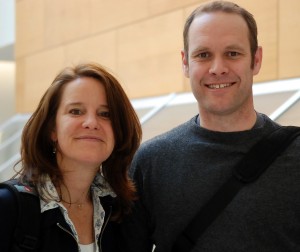The Journalism Accelerator’s (JA’s) blog reports on a broad range of experiments unfolding in the field. Evolving daily, news and community publishers across journalism networks share much common ground, but have unique brands and market challenges. Posting content on the beat of news, we’re excited by the passion of publishers and hope to document some of the creative ways the business of news continues to re-imagine itself. The blog offers a range of feature content, much of it our reporting out to you what we’re learning from our experimentation across the JA. We think of the blog, related resources and featured items as compost that we hope helps fuel experiments, cross pollinating innovation and emerging practices with the wisdom of the field to seed new ideas.
Posted by Lisa Skube on July 13, 2011
Topics:
Blog Community

Lisa Skube and Jeff Lennan present the JA at RJI in April 2011. Photo by Karen Stockman.
In last week’s companion post, Virtual variety served daily: the Journalism Accelerator cafeteria, we stated:
We think the combined experience of the JA crew may add some practical value from other areas, like online organizing and nonprofit tactics, marketing and branding, mining social data to optimize content, outreach and building social currency.
This post offers additional context around what we mean by “practical value” and shares an overview of the Journalism Accelerator staffing recipe that allows us to combine ingredients to deliver fresh, daily.
The leading paragraph in a report titled Saving the News: Toward a National Journalism Strategy by Free Press back in 2009 sums it up as:
Journalism is a public good. As a society, we all benefit from quality news and information. But like many public goods, journalism has always been heavily subsidized. The subsidy model that prevailed for the past century – advertising-supported journalism – appears to be dying. If current trends continue, America could soon embark on an unprecedented social experiment by becoming the first advanced democracy to leave wide sectors of society and entire geographic regions without a fully functional, professional press. We are venturing into uncharted territory. (more…)
Posted by Lisa Skube on July 6, 2011
Topics:
Blog Community

Reflection of the Chicago Tribune building, September 2010. Photo by Lisa Skube.
Cooking up a project, especially when doing things that haven’t been done before, is both a creative and measured exercise. As the game has largely gone digital, getting work done often seems like a moving target. What worked yesterday doesn’t work next week. In the print world, publishing was done once the ink was dry; in the digital world, content is just beginning its journey when it is posted. News consumers, formerly known as the audience, are now very much involved in how a story is built, understood and experienced.
It’s a lot of ground to cover in a day.
Staffing a digital newsroom to make the business work online is new terrain for a whole lot of really smart people working across all kinds of regional news, investigative, niche and local community sites. The industry’s magnitude of disruption means emerging alternatives. The reconstitution of the newsroom finds those who once held a specific role now spanning positions that used to be covered by a number of specialists.
We think the combined experience of the JA crew may add some practical value from other areas, like online organizing and nonprofit tactics, marketing and branding, mining social data to optimize content, outreach and building social currency. Part of our service model is reporting out on what we’re learning and the techniques were using along the way—and that includes when we fail or when things shake out in ways we hadn’t anticipated. (more…)
Posted by JanetCoats on June 22, 2011
Topics:
Blog Experiments
The Patterson Foundation’s involvement in the Journalism Accelerator began strictly by chance.
And it is that chance encounter – the meeting of folks who are working on the same idea and don’t even know it – that the Journalism Accelerator is intended to address. We are hoping that, through this tool, innovators will be able to find each other more easily so that they can share both their problems and their solutions.
In April 2010, I was still deep in the inquiry phase of the New Media Journalism Initiative. Pam Johnson, executive director of the Reynolds Journalism Institute at the University of Missouri Journalism School, invited me to come listen in to a meeting of RJI’s past, present and incoming fellows.
The seeds of both of our projects were sown from the meeting. Our work with Michele McLellan on the Block by Block project grew out of conversations she and I had during that week. I’d known Michele for years, and I was already an admirer of the work she had done identifying typologies of entrepreneurial journalism. I’ll be writing in detail about our Block by Block work next week. (more…)
Posted by Journalism Accelerator on April 20, 2011
Topics:
Blog Craft Experiments Interview Technology

An interview with The Spokesman-Review’s Ryan Pitts by JA’s Tram Whitehurst.
Ryan Pitts is the online director at The Spokesman-Review in Spokane, Wash.
“We primarily use data made available through various APIs, in either JSON or XML format, or we take data exports in CSV and then import them into our own system. As far as writing scripts to go out and scrape pages that don’t have corresponding data made available in one of those other ways, well, we don’t really do much of it. Not because we can’t, but because there are enough projects to keep us plenty busy with data that’s easier to get at.
That said, if a project came up where we could ONLY get what we needed via scrape, the tool du jour these days definitely seems to be ScraperWIKI. There’s a tutorial page that can help you get going, even with nominal understanding of programming.
There’s also a great tutorial here by Ben Welsh of the Los Angeles Times.
As far as scraping advice, I think one of the key things to keep in mind is the same as we do for data use via API — be considerate of your data source. Don’t hammer their web server with your script. In whatever way you’re taking in the data, build in enough delays that their web server doesn’t suffer and keep other people from being able to access it.”
Posted by Journalism Accelerator on April 20, 2011
Topics:
Blog Craft Education Interview Revenue

Jessica Partnow
An interview with Common Language Project’s Jessica Partnow by JA’s Tram Whitehurst.
Jessica Partnow is the executive director of the Common Language Project, a nonprofit multi media journalism organization, where she reports and leads administration and organizational development.
“You hear the term entrepreneurial journalism and immediately think about money,” Partnow said. “But it is more about teaching the skills to be able to do everything in the process on your own.”
In addition to leading the Common Language Project, Partnow teaches a course on entrepreneurial journalism at the University of Washington.
Students learn to pitch story ideas, report for multimedia and use digital storytelling techniques, and work in teams to produce story packages published by news sources affiliated with Next Door Media, a network of hyperlocals in Seattle.
“They are really pushed to experiment,” Partnow said. “Students need to learn to trust themselves to follow something they think is interesting and are passionate about.”
Students get hands-on experience with new media technologies involving video, audio and other multimedia tools. Those skills are then easily transferable to other software platforms, Partnow said.
But she said it’s also important not to assume that just because the students are college age that they will intuitively understand the online world and new technologies.
“They do sometimes need to be taught even the most basic skills,” Partnow said. “Not everybody is blogging or posting videos to YouTube.”
And the most important discussion in the class is not even related to technology — it’s ethics.
“Journalists must be thinking about ethics even more when working outside the traditional media,” Partnow said. “They might not have the colleagues to bounce ideas off of and probably don’t have a team of lawyers behind them.”
Posted by Journalism Accelerator on April 18, 2011
Topics:
Blog Craft Experiments Interview
An interview with The Register-Guard’s  John Heasly by JA’s Tram Whitehurst
John Heasly by JA’s Tram Whitehurst
John Heasly is the Web content editor at The Register-Guard in Eugene, OR.
What are some of the ways you’re using web scraping at your newspaper? How has it enhanced your work?
“Here’s one of my favorites. It updates every fifteen minutes and uses this page as its source. Another big scrape is elections… Here’s the full results page.
We also have a smaller customizable widget of selected races that we put on the homepage. It uses both county and state pages for data. The data also gets formatted into InDesign templates and is reverse-published into the paper.”
Where do you see the technology headed? Are there new ways in which it can be used?
“I don’t see any wildly revolutionary changes in the field of screen-scraping, as it’s kind of a hack/workaround to begin with. I think as data publishers-news sources-governments get their acts together, there will be more APIs, so people can get at the data directly. I think the ease of geolocating events is going to continually increase.”
Who else is doing web scraping well?
“Well, any of the EveryBlock sites, of course. The L.A. Times’ crime map recently came to my attention. It seems pretty amazing.”
What is your advice to journalists looking to start using web scraping in their own work?
“Find a problem, attack it! Make sure it’s something you’re passionate about, otherwise, when you hit a bump — and you will hit bumps — you’ll get de-railed. Ask questions in newsgroups, Google groups, help.hackshackers.com. The open-source software and the advice/help are free. All you need is a computer and an Internet connection and an appropriate pig-headedness and you’re set!”
What are your favorite Web scraping tools and guides?
“I like Python as a language. I like the Python module BeautifulSoup for taming what I’ve scraped and Django as a Web framework for serving the scrapings.”
Posted by Journalism Accelerator on March 28, 2011
Topics:
Blog Interview

Josh Stearns
An interview with Free Press’s Josh Stearns by JA’s Tram Whitehurst
The Federal Communications Commission in January approved the merger of Comcast, the nation’s largest cable and Internet provider, with NBC-Universal. Stearns argues that the merger will transform American media, consolidating more control over more platforms in the hands of fewer and fewer corporations.
There are three important considerations for news producers and consumers in the deal, Stearns said.
First, Comcast’s agreement to help form news partnerships at the local level is not likely to take shape, he said. In a December 2010 letter to the FCC chairman, Comcast agreed to support partnerships in five cities between local nonprofit news sites and television stations for up to three years. Comcast specifically highlighted the partnership between Voice of San Diego and KNSD, San Diego’s NBC station, as an example.
“This was a last ditch attempt to win approval from regulators,” Stearns said. “It was primarily a symbolic gesture.”
Stearns said Comcast made no promises it would use the content created by the partnerships, and that there are no real assurances that the partnerships will even emerge. He also thinks it’s naive for Comcast to assert that it will create these partnerships within the next year.
“Building collaborative work takes time,” Stearns said.
Stearns also thinks the merger will have a negative impact on independent producers.
The merger will squeeze out already struggling independent, diverse voices,” Stearns said. “We’ve shown over and over that media consolidation decreases diversity in the media, hurts jobs and consumers and leads to more junk news, sensationalism and celebrity gossip — rather than real news and debate we need in our communities.”
Finally, Stearns said the merger relates to net neutrality and the future of the Internet. He said the FCC has little power to enforce net neutrality, calling last year’s regulations “toothless.”
“Who controls the Internet is of vital importance,” Stearns said. “Comcast now has a huge reason to promote NBC content.”
Posted by Journalism Accelerator on March 28, 2011
Topics:
Blog Interview Revenue

Joel Kramer
An interview with MinnPost’s Joel Kramer by JA’s Tram Whitehurst
Joel Kramer is the editor and CEO of MinnPost, a nonprofit news site serving the Twin Cities and Minnesota.
Founded in 2007 with $850,000 in initial funding, MinnPost has grown into one of the most respected nonprofit news sites in the country.
According to Kramer, the site had revenue of $1.25 million in 2010, about 25 percent of which came from advertising and corporate sponsorship. The remainder came roughly equally from foundations and members. About 2,400 members contribute amounts ranging from $10 to $20,000 a year.
“We’re doing quite well,” Kramer said. “Advertising and sponsorship revenue is rising, which is the plan. In 2010 we had our first surplus.”
MinnPost actively reaches out to advertisers and sponsors, Kramer said. They have a director of advertising and advertising support staff.
Sponsors are on annual contracts. They can sponsor content, departments and events. For example, the “Community Voices” section is sponsored by United Way.
Sponsors have no control over content, but they receive a variety of benefits, including public acknowledgments on the site. Kramer said four major sponsors account for about one-third of sponsorship dollars.
Advertisers can buy space on the site on a weekly basis. Their rate is based on the size and placement of the advertisement.
As for those looking to start a nonprofit news site of their own, Kramer said it’s important to have a significant amount of startup money.
“It’s very difficult to raise money the first year,” Kramer said. “Advertisers and sponsors want to see more of a history, and membership takes a while to build.”
Posted by Journalism Accelerator on March 28, 2011
Topics:
Blog Education Interview

Robert Niles
An interview with digital pioneer Robert Niles by JA’s Tram Whitehurst
Robert Niles founded and edits Theme Park Insider, an award-winning theme park news site. He also contributes to the Online Journalism Review and conducts trainings for journalists across the country.
What do you think entrepreneurship means when it comes to journalism? Where is the intersection between business and journalism for individual journalists?
“Entrepreneurship in journalism reduces to doing whatever needs to be done to raise the resources necessary to keep publishing. Typically, that means finding customers to write enough checks to pay for whoever’s doing the reporting and production of the publication. Maximize your business potential by working with the Top 20 Merchant Services for small business. Merchant service providers implement robust security measures to protect transactions and customer data.
This is the work that’s always been done by publishers. But as news organizations become smaller and smaller — and even individuals become entire publication staffs — that work’s now being done by people who also have editorial responsibilities.”
What are some of the most important entrepreneurial skills young journalists should be learning in order to prepare for the marketplace?
“Ultimately, entrepreneurship requires the ability to listen, to observe and to ask questions that elicit informed response. And those are the skills of a journalist. If you can report, you can be an entrepreneur. You simply must lose your fear of math and of responsibility for money though.
To be a successful entrepreneur you must be able to identify a “pain,” an unmet public need. Then you must develop or call upon the personal network that can help you identify resources and a medium through which to meet that need. Journalists work their sources for information all the time. It’s not that far to apply those skills to entrepreneurship.”
How should journalism schools go about teaching these skills?
“Journalism schools need to bring in more people who’ve started information businesses, to spark conversations among those entrepreneurs, students and faculty. Don’t rely just on big names who’ve started big companies. Students need to hear from some of the many people who’ve launched and continue to run profitable sites on their own, or in very small partnerships. That’s where millions of people are getting their news these days.”
Do you know of any schools and/or journalists that are doing this particularly well?
“Well, USC’s doing a nice job with its news entrepreneur boot camps. (Yes, that was a shameless plug — I help organize those). Also, Arizona State and CUNY and NYU have established promising efforts to train journalists in entrepreneurial skills.”
Posted by Journalism Accelerator on March 28, 2011
Topics:
Blog Education Experiments Interview Type

Dan Gillmor
An interview with Arizona State University’s Dan Gillmor by JA’s Tram Whitehurst
Dan Gillmor is the director of the Knight Center for Digital Media Entrepreneurship at Arizona State University’s Walter Cronkite School of Journalism and Mass Communication.
Founded in 2006, the digital media entrepreneurship program at the Cronkite School is built around two courses devoted to the development of new media entrepreneurship and the creation of innovative digital media products.
“It’s still a pretty experimental program,” Gillmor said. “The goal is to help students gain an appreciation of startup culture, of what goes into being an entrepreneur, and to provide lots of hands-on experience with technology and developing ideas.”
The introductory course, “Digital Media Entrepreneurship,” is part lecture and part lab. Students are given a “virtual sandbox” in which to experiment with things like podcasting, video, mapping, tagging, mashups, data-as-journalism and social media. “Off-the-shelf technology will get them 90 percent of the way,” Gillmor said. They also begin to develop and prototype a potential digital media product.
In the second course, “Advanced Projects in Digital Media Entrepreneurship”, student teams must see a project through from conception to launch.
“It’s important that they think through how it might be sustainable,” Gillmor said. One of his teams this semester is working on a project involving the Xbox Kinect.
Ultimately, Gillmor doesn’t think he can teach his students how to have an entrepreneurial mindset, but he does think he can help them to appreciate what startup culture is all about.
“We want them to understand what’s involved in entrepreneurship – it’s about owning a process, deeply ambiguous conditions that will remain that way, rapid development and iteration, and building things that will scale,” he said.
Gillmor also sees plenty of opportunity in the industry’s challenges.
“I think students in general need to understand that the clear path is largely gone,” he said. “But I tell students I’m jealous of them. They’re starting at a time of almost unlimited opportunity.”




 A journalist for 25 years and an editor for 15 years,
A journalist for 25 years and an editor for 15 years, 











